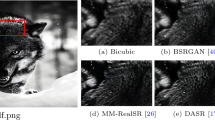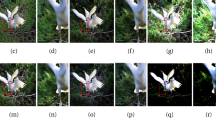Abstract
The images captured under low light conditions generally have less than satisfactory visual quality. To address this issue, many low-light image enhancement methods have been studied. However, these existing algorithms mostly suffer from unnaturalness, over-enhancement and artifacts. In this paper, a perceptive low-light image enhancement via multi-layer illumination decomposition model is proposed, to preserve the naturalness and improve the contrast for low-light images. First, the contrast of the target image is defined from global, local and the effect of noise aspects. Then, inspired by the human visual system, the perceptive contrast is designed by combining the defined contrast with just-noticeable-difference transformation. Last and most importantly, the target image is decomposed in a multi-layer way based on the multi-scale adaptive filter, which utilizes the perceptive contrast to decide the variance adaptively. This step can effectively obtain multiple illumination and reflectance layers. Combining these reflectance with adjusted illumination components can generate the final enhanced result. The proposed method has better no-reference quantitative measurement results than other compared methods. Experimental results on several public challenging low-light image datasets demonstrate that the proposed method can achieve great performance in balancing the contrast, brightness and naturalness.
















Similar content being viewed by others
References
Abdullah-Al-Wadud M, Kabir MH, Dewan MAA, CHae O (2007) A dynamic histogram equalization for image contrast enhancement. IEEE Trans Consum Electron 53(2):593–600
Cheng H, Long W, Li y, Liu H (2020) Two low illuminance image enhancement algorithms based on grey level mapping. Multimed Tools Appl
Chou CH, Li YC (1995) Perceptually tuned subband image coder based on the measure of just-noticeable-distortion profile. IEEE Trans on Circuits & Systems for Video Technology 5(6):467–476
Dabov K, Foi A, Katkovnik V, Egiazarian K (2007) Image denoising by sparse 3-d transform-domain collaborative filtering. IEEE Trans Image Process 16(8):2080–2095
Dicarlo JM, Wandell BA (2006) Rendering high dynamic range images. Proc Spie 3956:392–401
Dong X, Wang G, Pang Y, Li W, Wen J, Meng W, Lu Y (2011) Fast efficient algorithm for enhancement of low lighting video. In: 2011 IEEE international conference on multimedia and expo (ICME), pp 1–6
Edoardo P, Luca DC, Alessandro R, Daniele M (2005) Mathematical definition and analysis of the retinex algorithm. J Opt Soc Am A: Opt Image Sci Vis 22(12):2613–21
Eilertsen G, Mantiuk RK, Unger J (2015) Real-time noise-aware tone mapping. ACM Trans Graph 34(6):1–15
Fattal R, Lischinski D, Werman M (2002) Gradient domain high dynamic range compression. 21(3)
Feng X, Li J, Hua Z (2020) Low-light image enhancement algorithm based on an atmospheric physical model. Multimed Tools Appl 79(3)
Fu X, Liao Y, Zeng D, Huang Y, Zhang X, Ding X (2015) A probabilistic method for image enhancement with simultaneous illumination and reflectance estimation. IEEE Trans Image Process 24(12):4965–4977
Fu X, Zeng D, Huang Y, Liao Y, Ding X, Paisley J (2016) A fusion-based enhancing method for weakly illuminated images. Signal Process 129:82–96
Gonzalez RC, Woods RE (2007) Digital Image Processing, 3rd. Prentice-Hall, Upper Saddle River, NJ
Govind LP, Josemartin MJ (2019) Kerala Application of multi-stage filtering and multi-layer model in the context of dark and non uniformly illuminated images. In: 2019 2Nd international conference on intelligent computing, instrumentation and control technologies (ICICICT), vol 1, pp 615–620
Gu K, Wang S, Zhai G, Ma S, Yang X, Lin W, Zhang W, Gao W (2016) Blind quality assessment of tone-mapped images via analysis of information, naturalness, and structure. IEEE Transactions on Multimedia 18(3):432–443
Gu K, Lin W, Zhai G, Yang X, Zhang W, Chen CW (2017) No-reference quality metric of contrast-distorted images based on information maximization. IEEE Trans Cybern 47(12):4559–4565
Guo C, Li C, Guo J, Loy CC, Hou J, Kwong S, Cong R (2020) Zero-reference deep curve estimation for low-light image enhancement. In: 2020 IEEE/CVF conference on computer vision and pattern recognition (CVPR), pp 1777–1786
Guo X, Li Y, Ling H (2017) Lime: Low-light image enhancement via illumination map estimation. IEEE Trans Image Process 26(2):982–993
Hao S, Han X, Guo Y, Xu X, Wang M (2020) Low-light image enhancement with semi-decoupled decomposition. IEEE Transactions on Multimedia 22(12):3025–3038
Jayant N (1992) Signal compression: technology targets and research directions. IEEE Journal on Selected Areas in Communications 10(5):796–818
Jobson DJ, Rahman Z, Woodell GA (1997a) A multiscale retinex for bridging the gap between color images and the human observation of scenes. IEEE Trans Image Process 6(7):965–976
Jobson DJ, Rahman Z, Woodell GA (1997b) Properties and performance of a center/surround retinex. IEEE Trans Image Process 6(3):451–462
Kimmel R, Elad M, Shaked D (2003) Keshet r, A variational framework for retinex. Int J Comput Vis, Sobel I
Land EH (1977) The retinex theory of color vision. Sci Am 237 (6):108–129
Lee C, Lee C, Kim C (2012) Contrast enhancement based on layered difference representation. In: 2012 IEEE international conference on image processing (ICIP), pp 965–968
Li L, Wang R, Wang W, Gao W (2015) A low-light image enhancement method for both denoising and contrast enlarging. In: 2015 IEEE international conference on image processing (ICIP), pp 3730–3734
Li M, Liu J, Yang W, Sun X, Guo Z (2018) Structure-revealing low-light image enhancement via robust retinex model. IEEE Trans Image Process 27(6):2828–2841
Liao S, Hu Y, Xiangyu Z, Li SZ (2015) Person re-identification by local maximal occurrence representation and metric learning. In: 2015 IEEE conference on computer vision and pattern recognition (CVPR), pp 2197–2206
Lim J, Heo M, Lee C, Kim CS (2017) Contrast enhancement of noisy low-light images based on structure-texture-noise decomposition. J Vis Commun Image Represent 45:107–121
Lore KG, Akintayo A, Sarkar S (2017) Llnet: a deep autoencoder approach to natural low-light image enhancement. Pattern Recogn 61:650–662
Ma K, Zeng K, Wang Z (2015) Perceptual quality assessment for multi-exposure image fusion. IEEE Trans Image Process 24(11):3345–3356
Mittal A, Soundararajan R, Bovik AC (2013) Making a “completely blind” image quality analyzer. IEEE Signal Processing Letters 20(3):209–212
Panetta KA, Wharton EJ, Agaian SS (2008) Human visual system-based image enhancement and logarithmic contrast measure. IEEE Trans Syst Man Cybern Part B (Cybern) 38(1):174–188
Pisano ED, Zong S, Hemminger BM, Deluca M, Johnston RE, Muller K, Braeuning MP, Pizer SM (1998) Contrast limited adaptive histogram equalization image processing to improve the detection of simulated spiculations in dense mammograms. J Digit Imaging 11(4):193–200
Qiao Y, Liu Y, Yang X, Zhou D, Xu M, Zhang Q, Wei X (2020) Attention-guided hierarchical structure aggregation for image matting. In: 2020 IEEE/CVF conference on computer vision and pattern recognition (CVPR), pp 13673–13682
Ren X, Yang W, Cheng W, Liu J (2020) Lr3m: Robust low-light enhancement via low-rank regularized retinex model. IEEE Trans Image Process 29:5862–5876
Selim SZ, Ismail MA (1984) K-means-type algorithms: a generalized convergence theorem and characterization of local optimality. IEEE Transactions on Pattern Analysis and Machine Intelligence PAMI- 6(1):81–87
Steyer S, Lenk C, Kellner D, Tanzmeister G, Wollherr D (2020) Grid-based object tracking with nonlinear dynamic state and shape estimation. IEEE Trans Intell Transp Syst 21(7):2874–2893
Wang C, Ye Z (2005) Brightness preserving histogram equalization with maximum entropy: a variational perspective. IEEE Trans Consum Electron 51(4):1326–1334
Wang D, Niu X, Dou Y (2014) A piecewise-based contrast enhancement framework for low lighting video. In: 2014 IEEE international conference on security, pattern analysis, and cybernetics (SPAC), pp 235–240
Wang LW, Liu ZS, Siu WC, Lun DPK (2020) Lightening network for low-light image enhancement. IEEE Trans Image Process 29:7984–7996
Wang R, Zhang Q, Fu C, Shen X, Zheng W, Jia J (2019) Underexposed photo enhancement using deep illumination estimation. In: 2019 IEEE/CVF conference on computer vision and pattern recognition (CVPR), pp 6842–6850
Wang S, Luo G (2018) Naturalness preserved image enhancement using a priori multi-layer lightness statistics. IEEE Trans Image Process 27(2):938–948
Wang S, Zheng J, Hu HM, Li B (2013) Naturalness preserved enhancement algorithm for non-uniform illumination images. IEEE Trans Image Process 22(9):3538–3548
Wu Y, Song W, Zheng J, Liu F (2021) Non-uniform low-light image enhancement via non-local similarity decomposition model. Signal Processing Image Communication 93(2):116141
Xu J, Hou Y, Ren D, Liu L, Zhu F, Yu M, Wang H, Shao L (2020) Star: a structure and texture aware retinex model. IEEE Trans Image Process 29:5022–5037
Xu K, Yang X, Yin B, Lau RWH (2020) Learning to restore low-light images via decomposition-and-enhancement. In: 2020 IEEE/CVF conference on computer vision and pattern recognition (CVPR), pp 2278–2287
Xu X, Luo X, Ma L (2020) Context-aware hierarchical feature attention network for multi-scale object detection. In: 2020 IEEE international conference on image processing (ICIP), pp 2011–2015
Xueyang F, Delu Z, Yue H, Xiaoping Z, Xinghao D (2016) A weighted variational model for simultaneous reflectance and illumination estimation. In: 2016 IEEE conference on computer vision and pattern recognition (CVPR), pp 2782–2790
Yang W, Wang S, Fang Y, Wang Y, Liu J (2020) From fidelity to perceptual quality: A semi-supervised approach for low-light image enhancement. In: 2020 IEEE/CVF conference on computer vision and pattern recognition (CVPR), pp 3060–3069
Yu L, Su H, Jung C (2018) Perceptually optimized enhancement of contrast and color in images. IEEE Access 6:36132–36142
Zhang C, Yan Q, Zhu Y, Li X, Sun J, Zhang Y (2020) Attention-based network for low-light image enhancement. arXiv:2005.09829
Zhang X, Shen P, Luo L, Zhang L, Song J (2012) Enhancement and noise reduction of very low light level images. In: 2012 IEEE international conference on pattern recognition (ICPR), pp 2034–2037
Zhang Y, Zhang J, Guo X (2019) Kindling the darkness: a practical low-light image enhancer. arXiv:1905.04161
Zhu M, Pan P, Chen W, Yang Y (2020) Eemefn: Low-light image enhancement via edge-enhanced multi-exposure fusion network. In: AAAI Conference on artificial intelligence (AAAI), vol 34, pp 13106–13113
Author information
Authors and Affiliations
Corresponding author
Additional information
Publisher’s note
Springer Nature remains neutral with regard to jurisdictional claims in published maps and institutional affiliations.
This work was supported in part by National Natural Science Foundation of China under Grant 61702278, in part by Priority Academic Program Development of Jiangsu Higher Education Institutions and in part by Postgraduate Research & Practice Innovation Program of Jiangsu Province KYCX18_0902.
Rights and permissions
About this article
Cite this article
Wu, Y., Zheng, J., Song, W. et al. Perceptive low-light image enhancement via multi-layer illumination decomposition model. Multimed Tools Appl 81, 40905–40929 (2022). https://doi.org/10.1007/s11042-022-13139-w
Received:
Revised:
Accepted:
Published:
Issue Date:
DOI: https://doi.org/10.1007/s11042-022-13139-w




